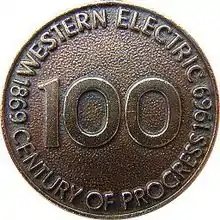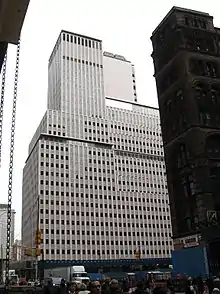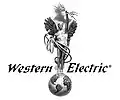Western Electric
The Western Electric Company was an American electrical engineering and manufacturing company officially founded in 1869. A wholly owned subsidiary of AT&T for most of its lifespan, it served as the primary equipment manufacturer, supplier, and purchasing agent for the Bell System from 1881 to 1984 when it was dismantled. The company was responsible for many technological innovations as well as developments in industrial management.
| Industry | Telecommunications |
|---|---|
| Fate | Absorption, remnants operating as Nokia |
| Successor | |
| Founded | 1869 |
| Defunct | February 7, 1996 |
| Headquarters | Manhattan, New York City, US. |
| Products | Telephones, Central office switches, computers, electrical and electronics parts, and all other telecommunications related products supplied to Bell System companies |
| Parent | AT&T (1881–1996) |
History

In 1856, George Shawk, a craftsman and telegraph maker, purchased an electrical engineering business in Cleveland, Ohio.[2]
In 1915, the assets of Western Electric Manufacturing were transferred to a newly incorporated company in New York, New York, named Western Electric Company, Inc,[3] a wholly owned subsidiary of AT&T. The sole reason for the transfer was to provide for the issuance of a non-voting preferred class of capital stock, disallowed under the statutes of the state of Illinois.[4]
In 1958, the company established the Engineering Research Center (ERC) near Princeton, New Jersey. With a charter distinct from Bell Labs, Western Electric's ERC was one of the first research organizations solely dedicated to the advancement of manufacturing-focused, rather than product-focused science.[5]
The first employee magazine was Western Electric News, commencing in March 1912 (Volume 1, Number 1) under company president Harry Bates Thayer. Its purpose was to provide a forum where ideas could be exchanged, the company events and activities could be recorded, and to serve as clearing house for technical and commercial information of value to the employee.[6]

Company logos
Western Electric used various logos during its existence. Starting in 1914 it used an image of AT&T's statue Spirit of Communication.
 1914 company masthead logo (Spirit of Communication)
1914 company masthead logo (Spirit of Communication) Logo until circa 1969
Logo until circa 1969 Logo 1969–1984
Logo 1969–1984
Manufacturing plants
In 1905, Western Electric began construction of the Hawthorne Works on the outskirts of Chicago and which, by 1914 had absorbed all manufacturing work from Clinton Street and Western Electric's other plant in New York City. Later large factories included the Kearny Works in Kearny, New Jersey, Columbus Works in Columbus, Ohio, and Kansas City Works in Lee's Summit, Missouri.[7] By the time AT&T was dissolved in the early 1980s, more than twenty production plants around the country ("Works" locations) had been established.[8][9] Locations of these facilities included:
- Columbia River Switching Equipment Works, Vancouver, Washington (crossbar switching equipment - 590 IBEW employees in 1974)[10][11]
- Hawthorne Works, Cicero, Illinois (metal parts/tools, capacitors, thin-film circuits, switchboards)
- Montgomery Works, Montgomery, Illinois (telephone parts)[12]
- Pittsburgh Works, Pittsburgh, Pennsylvania (plates/glass, 260 employees in 1966, established 1904)[13]
- Phoenix Works, Phoenix, Arizona (built in the 1960s for the manufacturing of cable and wire)[14]
NASA and Project Mercury
In 1960, NASA awarded Western Electric a contract for over $33,000,000 (equivalent to $285,195,726 in 2019) for engineering and construction of a tracking system for the Project Mercury program. As part of this effort, Western Electric engineers trained remote-site flight controllers and Project Mercury control center and operations personnel.[15]
References
- Western Electric, 195 Broadway, NY, NY, A Century of Progress, Employee gift card. (1969)
- Graybar history
- Jackson, Kenneth T. (1995). The Encyclopedia of New York City. New York, NY: The New York Historical Society; Yale University Press. p. 1254. ISBN 0-300-05536-6.
- Railway Signal Engineer, Volume 9 (January 1916) p33.
- Adams, Stephen B. Manufacturing the Future: A History of Western Electric. Page 163
- Western Electric News, 1 (1) (March 1912), Editorial, p. 1
- "History: Aerial view of Kansas City Works". Western Electric. Retrieved 2013-09-03.
- Iardella, Ed., Albert B. (1964). Western Electric and the Bell System: A survey of service (PDF). Western Electric. p. 36. Retrieved 2013-09-03.
- Smith, George David (1 May 1985). The Anatomy of a Business Strategy: Bell, Western Electric, and the Origins of the American Telephone Industry. Baltimore: Johns Hopkins University Press. ISBN 0-8018-2710-8.
- "Vancouver Lake Flood Control: Environmental Impact Statement". 4 April 1973. Retrieved 4 April 2018 – via Google Books.
- Stetson, Damon (4 September 1974). "Western Electric Operating Again". Retrieved 4 April 2018 – via NYTimes.com.
- Illinois Manufacturers Directory, 1962, Manufacturers' News, Inc. Chi. IL. p. 604–605, 1500 employees
- "What's a Cabinet Maker Doing in a Telephone Store?". Pittsburgh Post-Gazette. 19 January 1966. Retrieved 2013-09-03.
- "AT&T Network Systems". beatriceco.com. Retrieved 2018-07-18.
- Wade, Mark. "1960 Chronology". Encyclopedia Astronautica. Retrieved 2013-09-03.
Bibliography
- Adams, Stephen B., and Orville R. Butler. Manufacturing the Future: A History of Western Electric. Cambridge: Cambridge University Press, 1999. ISBN 0-521-65118-2.
- Fagen, M. D., ed. A History of Engineering and Science in the Bell System: Volume 1 The Early Years (1875–1925). New York: The [Bell Telephone] Laboratories, 1975. ISBN ?.
- Fagen, M. D., ed. A History of Engineering and Science in the Bell System: Volume 2 National Service in War and Peace (1925–1975). New York: The [Bell Telephone] Laboratories, 1978. ISBN 0-932764-00-2.
External links
| Wikimedia Commons has media related to Western Electric telephones. |
- Western Electric brand audio vacuum tubes
- Western Electric Dial Telephone Models
- Western Electric Historical Background, History of theater sound products
- The Papers of Ernest Galen Andrews at Dartmouth College Library